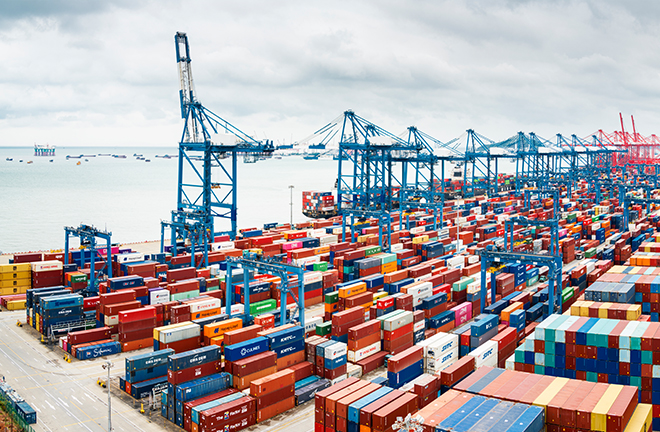Evolution of global industrial chains and trade in goods

Shenzhen Qianhai Comprehensive Bonded Zone in Shenzhen, Guangdong Province Photo: TUCHONG
Specialization within global industrial chains is a crucial variable driving shifts in the dynamics of trade in goods. The direction in which goods flow and the structure of trade in goods are determined by the spatial distribution of global industrial chains. Currently, a new technological and industrial revolution is catalyzing the evolution and upgrading of global industrial chains. Developed countries are reshoring their manufacturing operations, international trade rules are undergoing profound changes, and trade frictions are prompting gradual adjustments to the distribution of industries.
Influenced by uncertainties such as public health emergencies and geopolitical conflicts, the distribution of global industrial chains no longer exclusively follows the principle of cost minimization. Changes in the inherent logic of global industrial chains and external disturbances are becoming more complex and affecting the pattern of trade in goods. In addition to the economic rationale of cost minimization, four important factors will affect future distribution of industrial chains: diverse technological innovation, intelligent and digitalized industrial development, and the reconstruction of global economic governance rules.
First, technological innovation may emerge in multiple industries and countries. Significant progress has been made in new energy technologies, promising new technologies are being developed in the fields of biology and materials, and innovations in emerging industries have facilitated the diversification of industrial chains, reducing dependency on certain countries. Historically, key technologies were monopolized by individual nations or a select few multinational corporations. However, this paradigm is shifting, and opportunities are opening up for corporate development and the reconfiguration of industrial chains in emerging economies and developing countries.
Second, intelligent and digitalized industrial transformation will change the intensity of different elements in various segments of industrial chains and the organizational forms of specialization within industrial chains. Data and labor are integrated through extensive deployment of digital technology and data resources, reducing the demand for simple labor. Labor-intensive segments of industrial chains are being transformed into capital-intensive or technology-intensive segments, and specialization with manufacturing industrial chains will be reconfigured.
Third, factors such as industrial and national security are poised to enter the production function as new variables and will become important considerations for multinationals when arranging their processing and manufacturing bases, potentially outweighing economic factors. At present, the reshaping of global industrial chains is characterized by great power competition. Nations tend to place more emphasis on geopolitics and values, forming political alliances centered on industrial chains to maintain their advantages within the global industrial framework.
Fourth, the reconstruction of global economic governance rules fundamentally affects the rules of specialization with industrial chains. In particular, the development of new business models and new fields will require new rules. Parallel rule systems may arise in the digital economy, considering that rules in this field vary considerably due to different understandings of data flow.
The growth momentum of trade in goods could weaken, as specialization within global industrial chains is becoming regionalized and nearshored, and the length of specialization is being shortened in manufacturing segments. Geopolitical risks and other factors will also have an adverse impact on global trade. The growth rate of global trade in goods is expected to resemble a weak V shape, and the volume of global trade in goods is likely to decrease in the short term.
Today, a tri-polar configuration represented by “North America-Europe-Asia” has emerged within the global value chain network, with indications that the East Asian production network will solidify its advantages. In East Asia, the rapid growth of the middle class will drive the expansion of the regional consumer market, providing demand-side support for the formation of a somewhat closed loop within the East Asian production network. In addition, relevant industrial conditions for the East Asian production network have been continuously improved, giving rise to a well-developed industrial system.
Given the unchanged specialization logic in labor-intensive manufacturing segments of global industrial chains, developing countries will participate more extensively in global industrial chain specialization. However, with the enhancement of both their technological innovation and high-end manufacturing capabilities, some developing nations are now capable of taking over certain capital and technology-intensive manufacturing segments.
New industrial chain cooperation models, represented by the platform economy, enable manufacturing companies to directly connect with consumers, driving the development of new business models such as cross-border e-commerce. Multiple parallel and potentially overlapping regional industrial chains will become the new form of global industrial chain specialization. To maintain their own stability, individual regional industrial chains are bound to formulate trade rules benefiting themselves while excluding others, which may result in the fragmentation of global trade rules. Issues such as supply chain security, national security, and industrial security will become major areas of contention among countries in global economic governance.
Ji Jianjun et al. are from the Institute of Foreign Economic Research at the Academy of Macroeconomic Research affiliated with the National Development and Reform Commission of China.
Edited by WANG YOURAN
